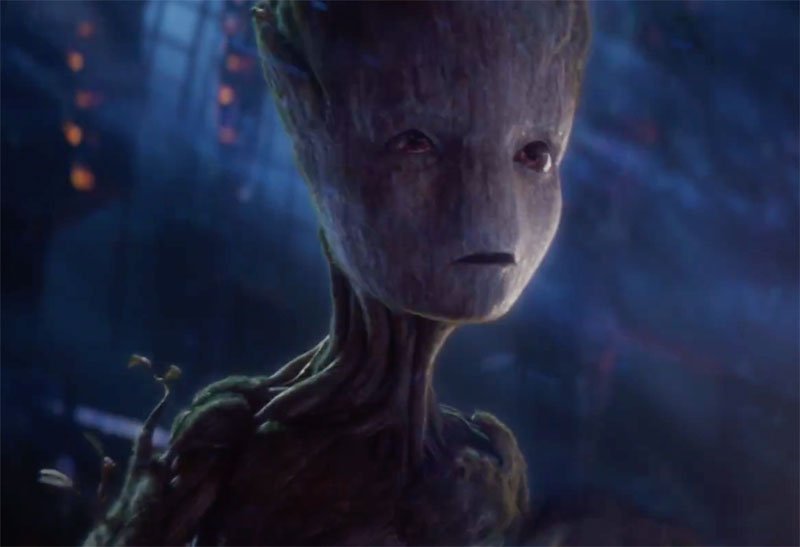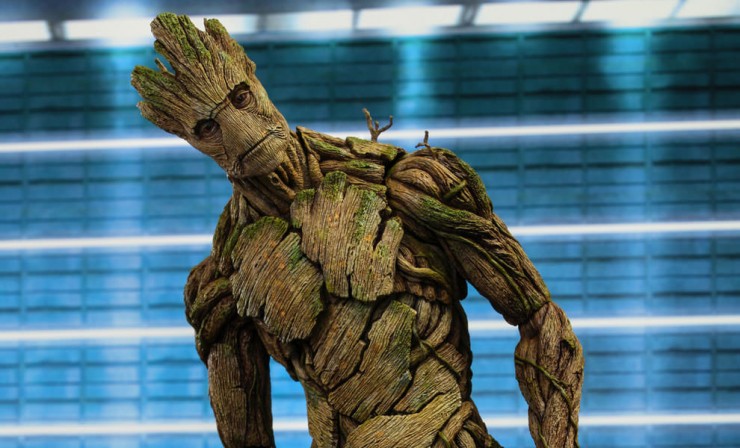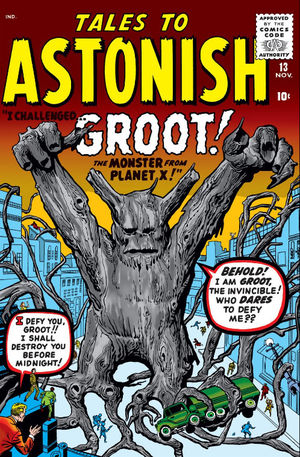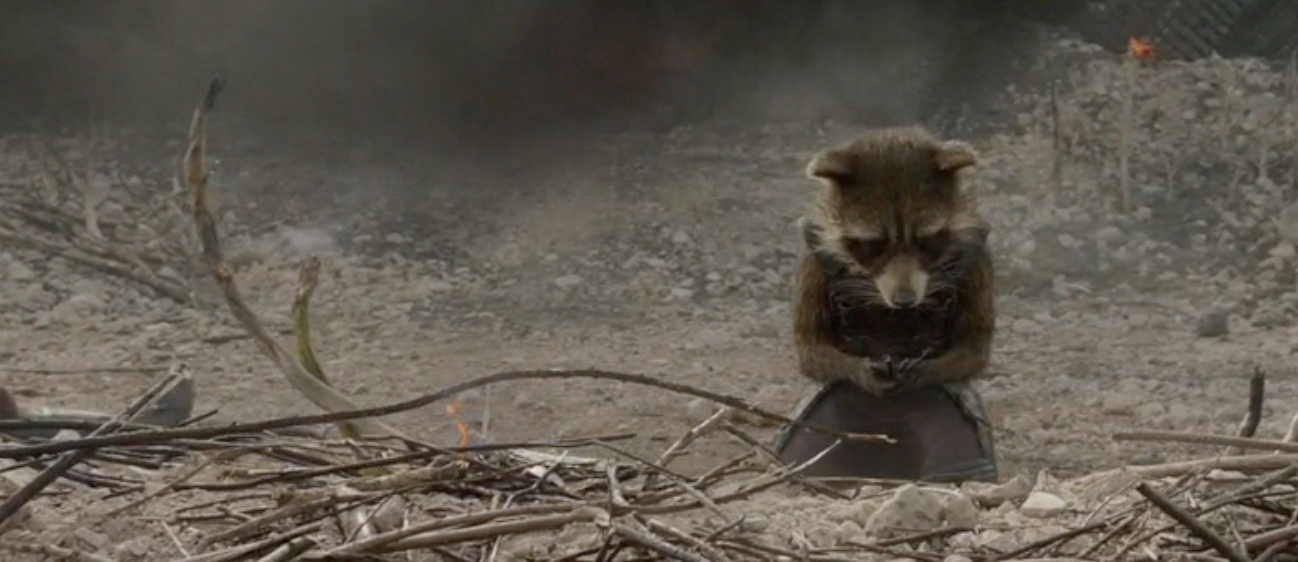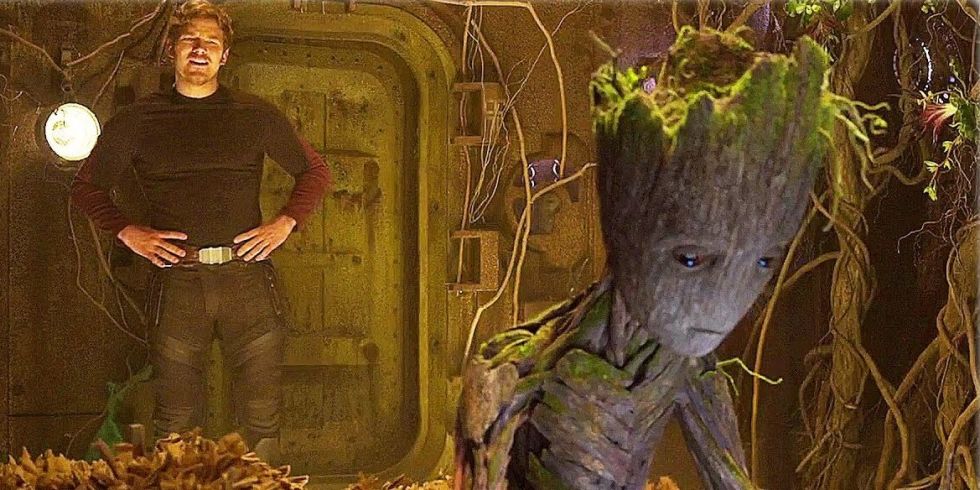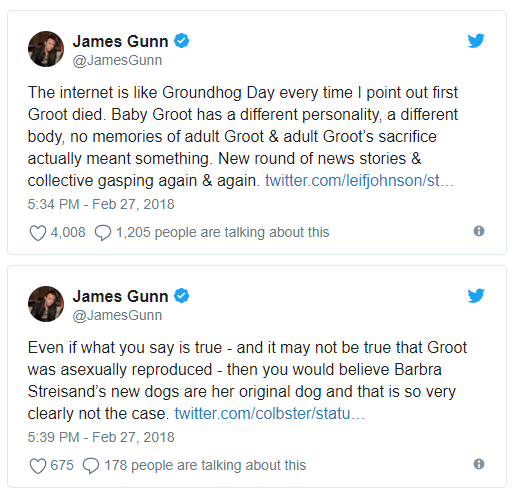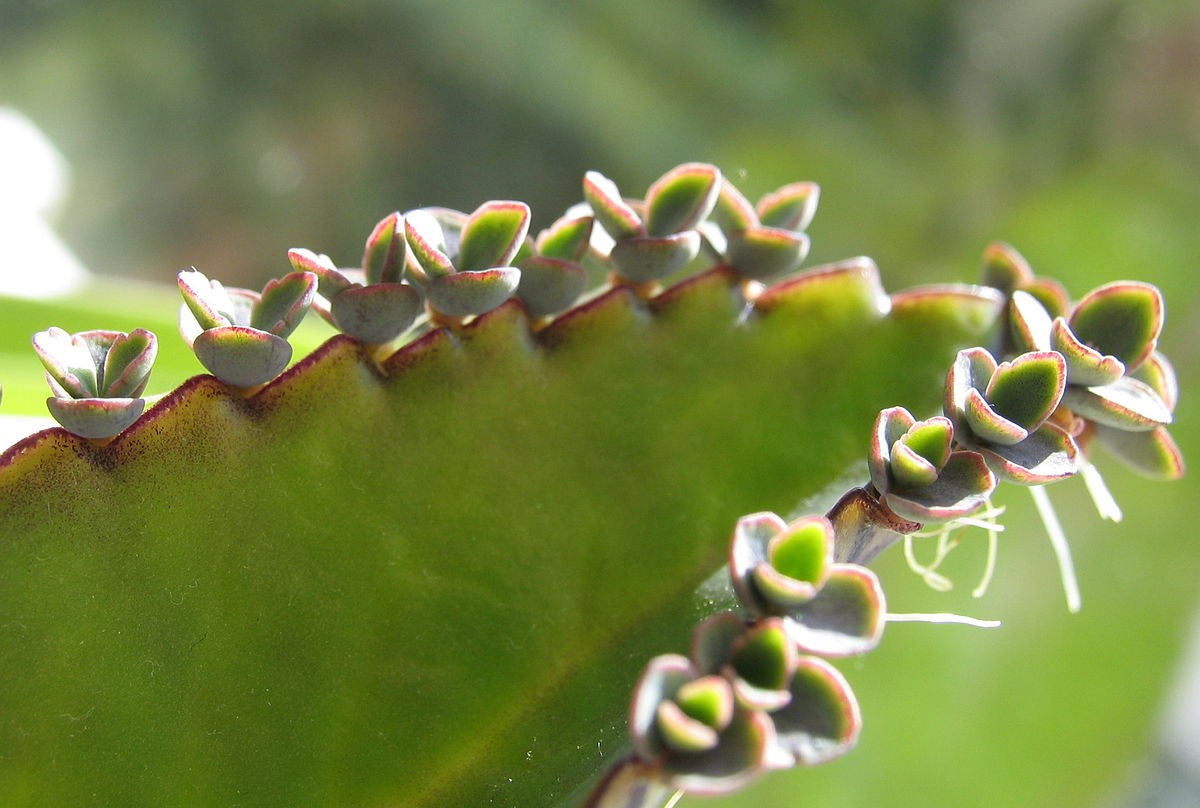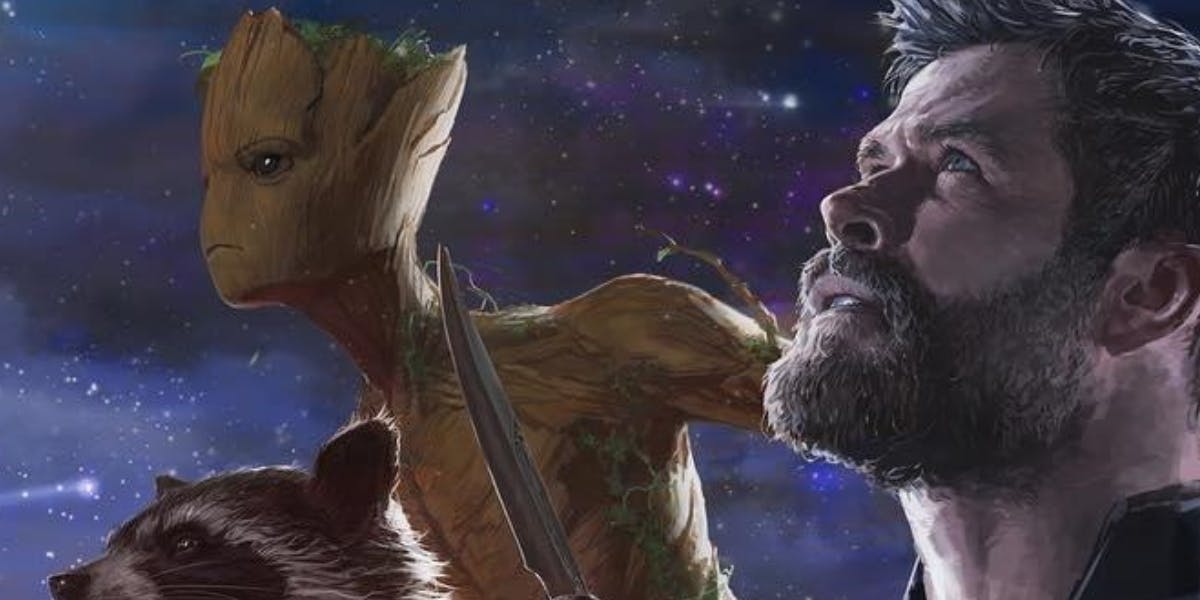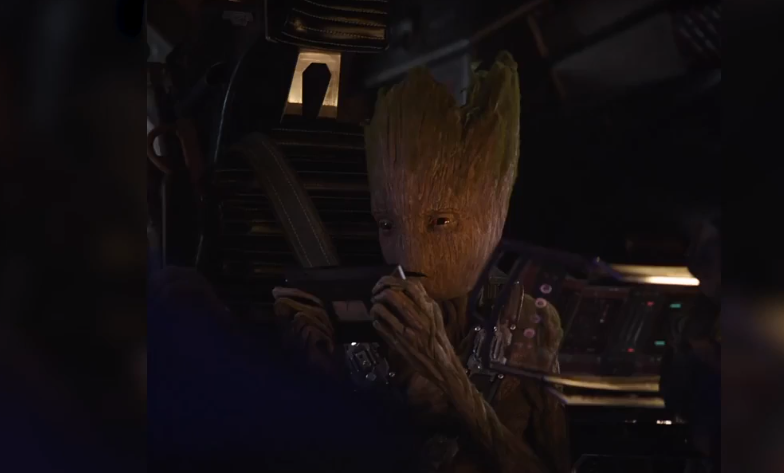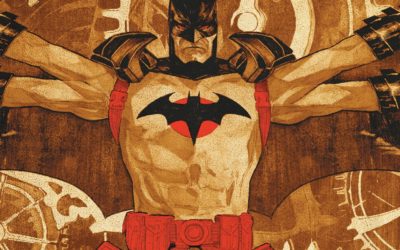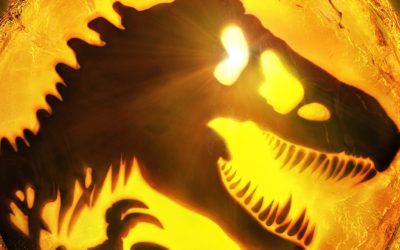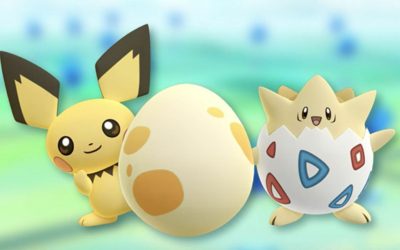Groot. Heart of the Guardians of the Galaxy. Wise. Cute. Annoying teen. Same plant? Son of original? Clone? How?
Okay – time to put the original Groot vs. Groot clone vs. son of Groot argument to bed here.
Maybe.
This week sees a teen-aged Groot appear in Marvel’s Avengers: Infinity War, and according to Guardians director James Gunn, who’s said it time and time again, new Groot is new. Old Groot – the tall tree Groot is dead, and this one, Baby Groot in Guardians of the Galaxy Vol. 2 and now Teen Groot: he’s a new Groot. As Gunn says, the current Groot is the son of Groot. As a result, the director explains, this Groot has a completely different personality, none of the memories of the first Groot, and is, in fact, much dumber than the original.
Gunn has marveled at the way this information seems to come as a surprise each time Young Groot shows up, most recently earlier this year as the trailers for Infinity War hit, showing Teen Groot…rebelling and using foul language…in his way.
Gunn’s tried everything – comparing Young Groot to Barbra Streisand’s cloned pet dogs, and how you would never say that the new dogs are her old dogs, or that his friends who are twins are actually the same people.
But you know – there’s been one thing, one view that’s been missing: a plant scientist weighing in on Groot and whether or not he’s the son or the same one. We’re here to fix that.
Dr. Brian Tague is a plant and cellular biologist at Wake Forest University, and, conveniently enough, knows what we’re talking about within just a few words of explanation.
Introductions over, let’s get into the science of plants and Groot’s reproduction.
Two things before we start:
- Yes – we’re talking about earth plants here, and Groot is certainly not that. Originally, Groot’s from “Planet X,” named as such in his first appearance in Tales to Astonish #13 (1960). So comparisons to earth plant life is a best guess, obviously.
- Thanks to the ubiquitousness and popularity of Marvel’s films, we didn’t have to spend any time familiarizing Dr. Tague with who Groot was or what he does. Which – okay, it might just be the long-time nerdity, but it’s pretty cool that Groot is pretty much a household name.
Onward.
Growing a New Groot
Let’s start with the start of this new Groot – back at the end of the first Guardians of the Galaxy movie. Rocket Raccoon picked up a shard of the first Groot and put it into a pot of dirt. That’s something that earth plants can do just as well. Okay – maybe not every bit of an earth plant can turn into a whole new plant, but…
“In general plant cells remain more totipotent – ‘able to turn into many different kinds of cells’ – than animal cells tend to be,” Tague said. “Animal cells can do the same thing though – for example, look at induced pluripotent stem cells – animal cells tend to just need more coaxing.
“One big idea that relates to this is: animals lay down a specific body plan and execute the plan, but once the ‘heart’ is made, the ‘heart’ plan is not used again. Plants are modular and can execute the ‘leaf’ plan over and over again. So plants cells remain more capable of executing the plan that will generate a new organ.”
That modularity makes plants blueprints and factories all in one, ready and able to build a whole new plant if and when they’re given the chance.
“My guess is that you can probably ‘vegetatively’ or ‘asexually’ propagate any plant,” Tague explained. “It may mean finding the best tissue and the right conditions – light, temperature, carbon and nitrogen sources, addition of plant hormones – to achieve it, but I am not aware of any plant that cannot be propagated from single cells or small bits of tissue.”
Applying this back to Groot – the science of starting a new Groot from a shard of the old Groot – right on. Not a big deal, as far as plant science goes. Heck – not a big deal as far as anyone who has ever grabbed some “babies” off of a spider plant knows (note the common term for the new starter plants…”babies.”)
Of course, given what Tague explained, it does leave a kind of yucky question to ponder…Rocket picked up one shard of the original Groot. One. Yeah, Groot kind of shattered in the crash landing of Ronan’s ship, and there are lots of visible pieces and shards all around. Rocket picked up one. As Tague indicated, they were most likely totipotent, that is, all of them were capable of becoming Groot. And Rocket only took one. Yeah – that image of little twigs with Baby Groot’s face, their little withered arms lifting to the sky, waiting to be picked up…drying up over time…desiccating…dying…
Okay – we’re going with the idea that somehow Rocket knew the shard he was looking for, and the rest was dead wood. No, it doesn’t make sense with the science that we were just talking about, but the alternative is…tiny arms reaching up to the sun and soft choruses of “I am Groot” growing fainter and fainter and…I’m not crying, you’re crying.
Or maybe the Nova Corps did cleanup and have a forest of Groots that are all annoying rebellious teens. Yeah – that fits better. We’re going with that. Even if we never see them again, we believe that there’s a sullen, moody Groot forest on Xandar.
Terminology
Some of the difficulty that Gunn has in explaining who the new Groot is seems to stem (ba-dum-bump!) from the fact that plants are just so…different from us animals. Yeah, we share the same genetic stuff in our cells (DNA), but after that, it’s pretty much like you had two (or three, looking at you, fungi) competing companies trying to figure out how to solve a problem – life. Animals did it one way with some minor variations along the way, and plants…plants did it their own way. And that way is pretty foreign to animals.
As a society, we’re still in the earliest stages of talking about animal clones. Dolly the cloned sheep and Barbra Streisand’s dogs aren’t separated by that many years. But when it comes plants – this cloning thing that we can still marvel at? That’s been a part of horticulture and agriculture for centuries.
For example, Tague didn’t even hesitate when asked what a cutting from an existing plant that starts growing as its own plant is called: “A cutting, its offspring, or a clone,” Tague said, adding, “If the cutting is grafted onto another plant – which is often done in viniculture, it is called a ‘scion.’”
In fact, the word “Clone” itself, which we can sometimes think of as a more recent, science-fiction-y thing goes back to the plant world for its origin. If we did think that, we’d all be wrong.
“The word ‘clone’ comes from the Greek ‘klon’ which means ‘twig.’” Tague explained. “So the origin of the word ‘clone’ comes from making identical individual plants by breaking off twigs and getting the twigs to root – the very process of Grooting!
“Of course, ‘clone’ now has come to mean ‘identical copy’ – identical twins, the two daughter cells that result from a bacteria undergoing fission, asexually propagated plant cuttings, or the identical copies of a plasmid DNA.”
As far as plants are concerned though, offspring = clone. And, if we can presume to clarify for him, that’s what Gunn keeps driving at, but comparing animal clones with plant clones blurs the line when you’re talking exclusively to an audience of animals. We can only assume that Gunn’s same explanation, given to a room full of ferns would be met with a thoughtful nodding of fronds.
But the thing is, and where the pushback Gunn has experienced comes in, is if you ask an animal – you’ll get a weird look if you suggested that a clone is an offspring. That’s because for virtually all of of our history – at least the part that we know about and kind of care about – animal offspring were created via sexual reproduction. Starting a plant from a cutting is asexual. No parents’ genes were exchanged. That’s our bias as animals, and it’s also a big issue to overlook.
To be fair – Gunn has, even though he calls Groot a clone – said that the reproduction of Groot may not have been asexual. We’re just going to let that go for now, though, and stick to earth-based plant science for our explanations and comparisons.
Groot Reproduction
Let’s go with the safe assumptions first before we get to some hypothetical ideas about Groot.
Given what we saw – Baby Groot was started from a shard/cutting of the original Groot – this was an example of asexual reproduction. Again – and this agrees with what Gunn has said most often, Baby – now Teen Groot is a clone of the original Groot. Using our earth-based science, that means that Teen Groot has the same genetic material as the original Groot with no contributions by another member of Groot’s species – if there are any (and we hope there are).
This form of reproduction – cloning – it’s good…well, if you’re us, and you’re trying to produce a large number of the same plant because it has really good characteristics that make more copies of exactly the same plant desirable. “This would usually entail taking a young cutting, often dipping it in ‘rooting hormone’ to encourage roots, putting the cutting in a suitable media and making sure that the atmosphere around the plant is very humid,” Tague said. “Without roots, the plant will dry out very quickly.”
In other words, without human – or genetically and technologically modified raccoon-like species – intervention, a cutting from a tree will certainly dry out before it sends out roots and starts a new tree. Which means…which means…which means the surviving members of the Nova Corps hauled ass to collect all the shards and branches of the original Groot and have a Teen Groot forest is what it means.
It has to mean that. Has. To.
Despite what we’ve talked about here, and how starting a new plant from a cutting is a viable way of making a new plant, it’s not any plant’s preferred form of reproduction. Sure, it’ll do in a pinch, but plants, like the birds and the bees prefer to reproduce sexually. Pollen and all of that.
“Asexual reproduction cloning gets you a monoculture – no genetic variability,” Tague explained. “When the new blight shows up – insect, fungus, bacteria – or there is a change in abiotic conditions, like water, light, etc. – everyone dies. Sexual reproduction generates genetic variability. It is constantly rearranging traits and characteristics. This genetic variability can serve as a buffer to changing conditions.”
So while Groot’s sprouting off clones seems to (in a way) make sense if Groot was a member of an opportunistic, colonizing species, what Tague said makes sense. You’d want a load of genetic variability within your population on the world you may have colonized, otherwise, if conditions are bad enough to kill one of you, conditions are probably be bad enough to kill everyone.
In our world, and, you can argue, in Groot’s world, sexual reproduction is for the best when it comes to plants. What we now see as Teen Groot may well be some emergency stress response – something that only happens when the “parent” Groot dies traumatically – a life raft of sorts for Groot’s genetic material to ensure continued existence. In some ways, this “emergency response” view is backed up by some of earth’s plant species.
“You can see this kind of thing when your tomato plants fall over,” Tague said. “Rather than give up, the part of the stem touching the ground is induced to make new roots and the part of the stem facing up will make new stems. That is the kind of situation where the totipotency of plants is really expressed.
“It’s not uncommon for an unrooted plant part to contact the ground and re-root. But as I said about humans doing this – the plant is in really danger of drying out before new roots are made. So I don’t think this really works as a general way of reproduction for plants. But – having said that, there are plants like ‘mother of millions’ that generates many little clonal offspring along there leaf edges – but again, these have roots already and won’t need any help from us.”
So again, maybe clone Groot is just means for Groot’s genetic material to continue on a until it can find a suitable “mate” for sexual reproduction.
Wait – speaking of a “mate” for Groot…
Is Groot a Male, a Female, or an Other?
You may remember at one time or another, something about male and female plants. If you’re ever in one of Dr. Tague’s classes, don’t go there. He’s not a fan of slipping them into our definitions of two sexes.
“‘Male’ and ‘female’ come loaded with cultural and social connotations that might obscure the science,” Tague said. “Plants can have two different ‘mating types’ that we refer to as male and female. The male plant produces a mobile gamete – pollen – like males in animals. Early development of the plant embryo takes place within ‘female’ plant tissue like animal ‘females’ – but that is where the similarities end.
“The reason we are tempted to call Groot a male is the tenor of its voice, its actions, its interactions with other characters – the cultural connotations of male. And also, we’re given no clue that Groot undergoes any kind of sexual reproduction at all. There may be only one ‘mating type’ that reproduces by cloning.”
In other words, Groot is Groot.
But again – if there is only this one type of reproduction and all Groots are Groot, then Groot is vulnerable to lots of problems down the road or across the stars.
Happy Birthday Forever, Groot?
Given the changes seen in Groot – from baby at the end of the first Guardians to adolescent at the end of the second Guardians movie and clearly teen in Infinity War, Groot’s “aging” quickly – as far as we try to map our definition of aging onto a plant that walks and talks.
But the means by which we are even talking about a Teen Groot kind of begs the question – could someone keep taking a shard from Groot over and over again as it gets older and keep that Groot going? In other words, if we flash-forward a thousand years in the Marvel Cinematic Universe to Guardians Vol. XCIX, will we see Groot? Not the same one that was in Infinity War, but one carrying the same genetic material that means its a clone of the Groot from the very first Guardians of the Galaxy?
In other words, could Groot, in a sense, be immortal?
“I think some of the oldest trees are upwards of 5000 years old,” Tague said. “But many organisms naturally senesce, fade and die. But here’s the thing – DNA replication and cell division is mutagenic. DNA replication introduces errors into the DNA at a low level – perfect replication would be near-infinitely expensive for the organism. So the more a cell divides, the more ‘errors’ accumulate. That implies that there is no immortality – eventually enough mutations would accumulate that the organism would not thrive.”
And Tague’s not talking about DNA replication connectected to sexual reproduction. This is straight up cell division by mitosis every time an organism grows a new cell. There are a few errors in the copy’s DNA. The more time passes, the more cell divisions, the more errors an organism accumulates.
There’s no doubt – Groot very well might be extremely long-lived, but the immortal Groot – given the self-cloning that it can undergo? Not likely. Groot’s own cell division will eventually bring it down.
So, big picture, where are we? Let’s make a list:
- Groot’s means of reproduction that was assisted by Rocket? That’s cloning. Baby/Teen Groot is a clone of the original Groot. At least as far as we understand plant science.
- This means of reproduction is asexual – there’s no new genetic material being introduced. It’s an okay means of reproduction in a pinch, but it has many inherent problems.
- Trying to assign a gender to Groot is a waste of time, and would probably annoy or confuse Groot.
But what can we conclude about Teen Groot – is it a “son” of the original Groot or is it the original Groot?
Yes.
Groot: Son vs. Original?
“I think there is an important point here,” Tague said. “Groot may be a plant. But he is a sentient plant. We don’t have anything to compare Groot to. It’s like if Groot was trying to figure us out and the only animal he had ever seen was sea sponge.
“Unlike the plants we know, Groot has visual, auditory and pain sensory systems more like animals. Groot feels emotion. So Groot must have plant-based biology that we know nothing about. That said, we have no real idea how Groot reproduces. Is the young Groot a clone? If the offspring is a nearly exact genetic copy, then yes, it is a clone.”
But – and again, this is where we, as a culture, are running up against newer vocabulary and meanings than we’re used to. Remember, for plants: clone = offspring.
“Does being an exact genetic copy make you the exact same being? No! Young Groot is going to have vastly different life experiences than Old Groot. Even identical twins have differences, and cloned calico cats look different from each other.
“So if you want to call young Groot a ‘son’ or ‘offspring,’ why not? It is a different individual. It may share the same ‘DNA,’ but not the same life. But – Groots may have encoded race memories – we don’t know it’s biology – so that it is genetically identical and share life experience or something like instincts.
“To turn it around, maybe Groots have methods of introducing genetic variability into the ‘cloned’ offspring they produce – maybe special groups of cells spread throughout Groot that can regenerate whole plants and have a molecular mechanism to generate variability – like antibody gene rearrangement. The point here is – we don’t know how a sentient plant would work. We just don’t have anything to compare it to.”
And if we had to have an answer from Tague – is he on Team Gunn or Team Internet?
“If I had to choose: Young Groot is a clone – it is genetically identical to Old Groot. It is also a son – it has an independent existence with a different life history – it will be culturally and socially different from Old Groot.”


